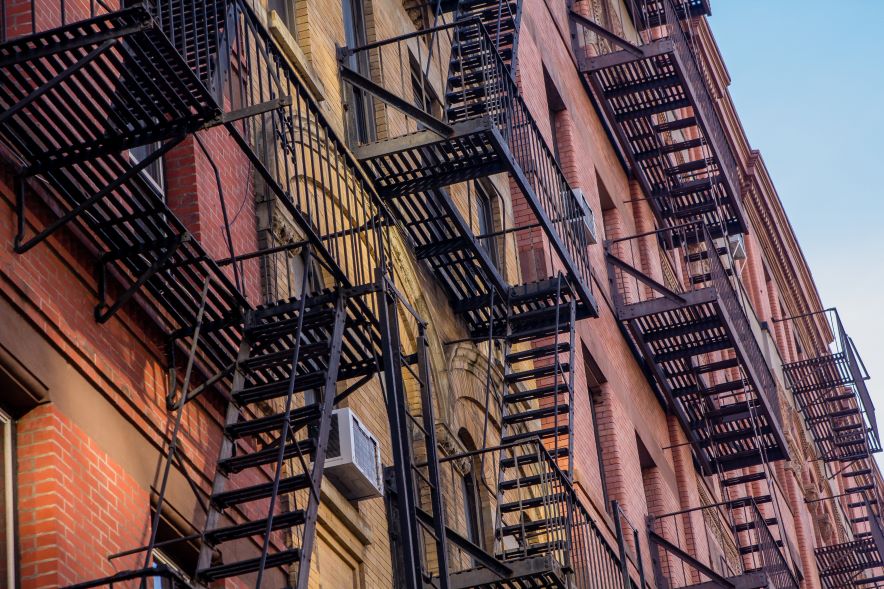Ensuring clear egress routes is vital for resident safety and is a primary focus of housing inspection protocols. With the implementation of the NSPIRE 3.0 standards, understanding the nuances of “Blocked Egress” rules has become more crucial than ever for property managers and owners. Our experts unravel the NSPIRE egress rules so you’re prepared for your inspections.
What is a Blocked Egress?
“Egress” refers to the action of going out of or leaving a place. In the context of building design and construction, egress typically refers to the pathways or routes that occupants can use to exit a building or an area safely in case of an emergency. These pathways are vital for safety and are subject to specific regulations and standards to ensure that occupants can quickly and safely evacuate if needed.
For instance:
- Egress windows: These are windows designed to be large enough for a person to climb out of in case of an emergency, especially useful in basements or other areas where standard exits might not be accessible.
- Means of Egress: This term encompasses the entire pathway from any point in a building to a safe exterior point, including aisles, corridors, stairways, exit doors, and more.
Ensuring proper egress is critical, especially in larger buildings or facilities where a significant number of occupants might need to evacuate quickly, such as during a fire or other emergencies. Building codes and safety regulations usually have strict requirements for egress to ensure the safety of occupants and the NSPIRE egress rules are no different.
A Deep Dive into the Three Deficiencies
1. Obstructed Means of Egress:
This deficiency pertains to any blocked exit, whether located within a unit or on the property’s exterior.
- Inside the Unit: Ensure all passages leading to exit points are free from obstructions to ensure residents can quickly and safely leave in the event of an emergency.
- Outside the Unit: Pay particular attention to exterior windows and doors. They shouldn’t be obstructed in any manner, including overgrown vegetation. It’s important to note that while HUD has de-emphasized vegetation as a standalone deficiency, it becomes relevant if it hinders egress routes, walkways, or ramps.
2. Obstructed Rescue Opening in Sleeping Rooms:
Limited to in-unit citations, this deficiency addresses any hindrance to a rescue opening in a sleeping area. HUD emphasizes that sleeping areas on the third floor or below must have accessible rescue openings.
- Resident-Owned Property Exemption: If the obstruction is resident-owned and located within the sleeping room, it isn’t considered a deficiency. However, if such an obstruction exists in other areas of the unit, it’s a notable deficiency, regardless of ownership. Though individual inspector interpretations may vary, prioritizing tenant safety by ensuring clear egress paths is recommended.
3. Obstructed Fire Escape Access:
For properties equipped with exterior fire escapes, this deficiency is of paramount importance.
- In-Unit Citation: Any obstruction to fire escape access can lead to this deficiency being cited, ensuring a clear pathway is vital.
- Resident-Owned Property Clause: As with the sleeping room clause, resident-owned items shouldn’t be classified as obstructions when assessing fire escape access.
Prioritizing Tenant Safety
While HUD’s NSPIRE 3.0 guidelines provide a clear framework for property assessments, the broader goal remains the same: ensure the safety and well-being of residents. By understanding and adhering to these standards, housing providers can ensure a safer environment for their tenants, especially during emergencies.
Seeking NSPIRE Expertise?
For any clarifications, inspections, or training needs related to REAC and NSPIRE protocols, trust the expertise of [Your Organization].
- Pre-REAC Inspections
- NSPIRE/UPCS/REAC 100% Annual Inspections
- Shadowing on your official REAC Inspection day
- Expert guidance on REAC Appeals
- Comprehensive NSPIRE/UPCS/REAC training sessions, available online and offline
- Specialized HCV/HQS Inspections
Reach out today and let us assist you in ensuring your property not only meets but exceeds the set standards.





